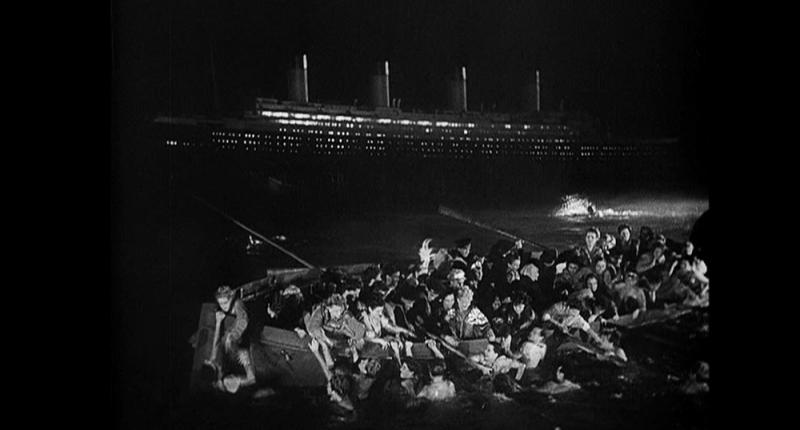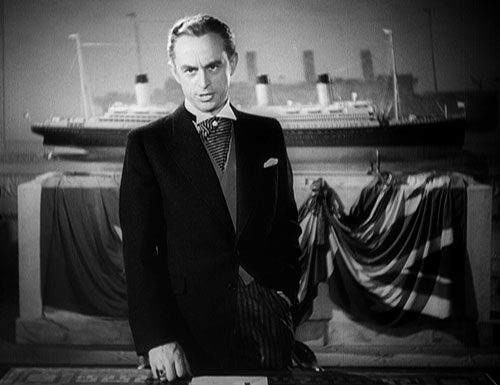Revealed: The Nazi Titanic, Channel 5 | reviews, news & interviews
Revealed: The Nazi Titanic, Channel 5
Revealed: The Nazi Titanic, Channel 5
How Joseph Goebbels planned to sink the British with big-budget propaganda movie

With the smoke from Julian Fellowes' upcoming Titanic mini-series for ITV becoming visible over the horizon, Channel 5 nipped in with this startling new spin on the tale of the doomed liner. It's not widely known that when the Nazis were riding high in the early part of World War Two, they hit upon a plan to turn the Titanic story into a blockbuster propaganda film, designed to throw contempt and ridicule over Britain's ruling elite.
Using a variety of film historians and critics from Germany, Britain and the USA, as well as the recently rediscovered production diaries kept by the film's art director, The Nazi Titanic offered intriguing glimpses into the value the Nazis placed on propagandist film-making, as well as on the way Hitler's regime viewed the British. Joseph Goebbels, the Third Reich's Minister of Propaganda, considered Britain to be "a sham democracy ruled by plutocrats" (not much change there then). The Nazi film would use the Titanic, with its upper decks versus lower decks class structure, as the perfect metaphor for a Britain being driven to destruction by its entrenched ruling elite.
 From his experiences with making anti-Semitic films like Jew Süss, Goebbels had learned that dramatised stories were more effective at seizing the popular imagination than documentaries, so bags of creative licence would be taken with Titanic. The narrative was cast as a stark fable of rampant capitalism versus the proletariat. It opened with a scene in which J Bruce Ismay (pictured above in movie), chairman of the White Star Line which operated the Titanic, addressed a room full of shareholders, telling them that their holdings would rocket in value as the ship broke the transatlantic speed record. Caution would be thrown to the winds to achieve that objective, with the ship's captain to be incentivised by bonus payments for every hour by which he broke the record.
From his experiences with making anti-Semitic films like Jew Süss, Goebbels had learned that dramatised stories were more effective at seizing the popular imagination than documentaries, so bags of creative licence would be taken with Titanic. The narrative was cast as a stark fable of rampant capitalism versus the proletariat. It opened with a scene in which J Bruce Ismay (pictured above in movie), chairman of the White Star Line which operated the Titanic, addressed a room full of shareholders, telling them that their holdings would rocket in value as the ship broke the transatlantic speed record. Caution would be thrown to the winds to achieve that objective, with the ship's captain to be incentivised by bonus payments for every hour by which he broke the record.
To bring this fiendishly cunning concept to fruition, Goebbels had recruited his favourite film-maker, 38-year-old Herbert Selpin, who had already pleased the great propagandist with a couple of successful action movies. Goebbels was determined to out-do Hollywood, and no expense would be spared for the Titanic project. The boat would, as it were, be pushed out, to the tune of 4 million Reichsmarks (about £100m). Selpin hurled himself into the spirit of the operation by ordering enormous studio sets to be built in Berlin as well as a 20-foot replica of the Titanic for the sinking scenes, while also demanding the use of a full-sized ship for exterior sequences.
All his wishes were granted, which didn't alter the fact that a curse seemed to loom over the project. When they lugged the model Titanic and truckloads of equipment to a lake near Berlin to shoot the sinking, their efforts were thwarted by appalling weather and technical problems. When the crew moved to the Baltic coast where they'd been given a real live ocean liner, the Cap Arcona, to play with, the shooting schedule was thrown into chaos by incompetent actors and the drunkenness of German servicemen who'd been drafted in to play supporting roles. Selpin launched into a tirade against the German military and the whole Nazi war effort, but was denounced to the authorities in Berlin by his friend and the film's scriptwriter, Walter Zerlett-Olfenius. He was flung into a Gestapo prison cell, where he was found hanged the following morning (bad news reaches the Titanic's bridge, pictured below).
 Goebbels hired a new director and the project ground on, but by the time he watched a cut in December 1942, the mood in Germany had turned from blaring triumphalism to Stalingrad-induced gloom, lit by the flashes of Allied bombs falling on the Fatherland. Goebbels grasped that scenes of terrified passengers drowning at sea had suddenly become symbolic not so much of Britain but of the state of the Reich, and the film was scrapped. In a hideous postscript, days before the German surrender almost 5,000 concentration camp inmates died in the destruction of the Cap Arcona, which was being used as a death ship by the SS. That was three times more than on the Titanic.
Goebbels hired a new director and the project ground on, but by the time he watched a cut in December 1942, the mood in Germany had turned from blaring triumphalism to Stalingrad-induced gloom, lit by the flashes of Allied bombs falling on the Fatherland. Goebbels grasped that scenes of terrified passengers drowning at sea had suddenly become symbolic not so much of Britain but of the state of the Reich, and the film was scrapped. In a hideous postscript, days before the German surrender almost 5,000 concentration camp inmates died in the destruction of the Cap Arcona, which was being used as a death ship by the SS. That was three times more than on the Titanic.
The Nazi Titanic did enjoy a sort of ghostly resurrection. Some of its special effects footage later appeared in the 1958 British film A Night to Remember, a documentary-like account of the loss of the Titanic. This wasn't widely advertised, as you can imagine.
Watch Revealed: The Nazi Titanic on Demand 5
Explore topics
Share this article
Add comment
The future of Arts Journalism
You can stop theartsdesk.com closing!
We urgently need financing to survive. Our fundraising drive has thus far raised £49,000 but we need to reach £100,000 or we will be forced to close. Please contribute here: https://gofund.me/c3f6033d
And if you can forward this information to anyone who might assist, we’d be grateful.

Subscribe to theartsdesk.com
Thank you for continuing to read our work on theartsdesk.com. For unlimited access to every article in its entirety, including our archive of more than 15,000 pieces, we're asking for £5 per month or £40 per year. We feel it's a very good deal, and hope you do too.
To take a subscription now simply click here.
And if you're looking for that extra gift for a friend or family member, why not treat them to a theartsdesk.com gift subscription?
more TV
 Down Cemetery Road, Apple TV review - wit, grit and a twisty plot, plus Emma Thompson on top form
Mick Herron's female private investigator gets a stellar adaptation
Down Cemetery Road, Apple TV review - wit, grit and a twisty plot, plus Emma Thompson on top form
Mick Herron's female private investigator gets a stellar adaptation
 theartsdesk Q&A: director Stefano Sollima on the relevance of true crime story 'The Monster of Florence'
The director of hit TV series 'Gomorrah' examines another dark dimension of Italian culture
theartsdesk Q&A: director Stefano Sollima on the relevance of true crime story 'The Monster of Florence'
The director of hit TV series 'Gomorrah' examines another dark dimension of Italian culture
 The Monster of Florence, Netflix review - dramatisation of notorious Italian serial killer mystery
Director Stefano Sollima's four-parter makes gruelling viewing
The Monster of Florence, Netflix review - dramatisation of notorious Italian serial killer mystery
Director Stefano Sollima's four-parter makes gruelling viewing
 The Diplomat, Season 3, Netflix review - Ambassador Kate Wyler becomes America's Second Lady
Soapy transatlantic political drama keeps the Special Relationship alive
The Diplomat, Season 3, Netflix review - Ambassador Kate Wyler becomes America's Second Lady
Soapy transatlantic political drama keeps the Special Relationship alive
 The Perfect Neighbor, Netflix review - Florida found-footage documentary is a harrowing watch
Sundance winner chronicles a death that should have been prevented
The Perfect Neighbor, Netflix review - Florida found-footage documentary is a harrowing watch
Sundance winner chronicles a death that should have been prevented
 Murder Before Evensong, Acorn TV review - death comes to the picturesque village of Champton
The Rev Richard Coles's sleuthing cleric hits the screen
Murder Before Evensong, Acorn TV review - death comes to the picturesque village of Champton
The Rev Richard Coles's sleuthing cleric hits the screen
 Black Rabbit, Netflix review - grime and punishment in New York City
Jude Law and Jason Bateman tread the thin line between love and hate
Black Rabbit, Netflix review - grime and punishment in New York City
Jude Law and Jason Bateman tread the thin line between love and hate
 The Hack, ITV review - plodding anatomy of twin UK scandals
Jack Thorne's skill can't disguise the bagginess of his double-headed material
The Hack, ITV review - plodding anatomy of twin UK scandals
Jack Thorne's skill can't disguise the bagginess of his double-headed material
 Slow Horses, Series 5, Apple TV+ review - terror, trauma and impeccable comic timing
Jackson Lamb's band of MI5 misfits continues to fascinate and amuse
Slow Horses, Series 5, Apple TV+ review - terror, trauma and impeccable comic timing
Jackson Lamb's band of MI5 misfits continues to fascinate and amuse
 Coldwater, ITV1 review - horror and black comedy in the Highlands
Superb cast lights up David Ireland's cunning thriller
Coldwater, ITV1 review - horror and black comedy in the Highlands
Superb cast lights up David Ireland's cunning thriller
 Blu-ray: The Sweeney - Series One
Influential and entertaining 1970s police drama, handsomely restored
Blu-ray: The Sweeney - Series One
Influential and entertaining 1970s police drama, handsomely restored
 I Fought the Law, ITVX review - how an 800-year-old law was challenged and changed
Sheridan Smith's raw performance dominates ITV's new docudrama about injustice
I Fought the Law, ITVX review - how an 800-year-old law was challenged and changed
Sheridan Smith's raw performance dominates ITV's new docudrama about injustice

Comments
The sinking of the "Cap